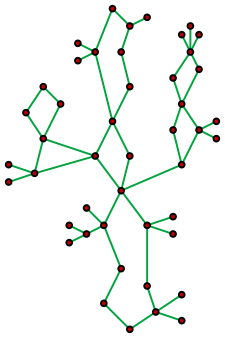CAC - Cactus
In the mathematical field of graph theory, a spanning tree T of a connected, undirected graph G is a tree composed of all the vertices and some (or perhaps all) of the edges of G. Informally, a spanning tree of G is a selection of edges of G that form a tree spanning every vertex. That is, every vertex lies in the tree, but no cycles (or loops) are formed. On the other hand, every bridge of G must belong to T (a bridge is an edge whose deletion increases the number of connected components).
A spanning tree of a connected graph G can also be defined as a maximal set of edges of G that contains no cycle, or as a minimal set of edges that connect all vertices. - Wikipedia In graph theory, a cactus (sometimes called a cactus tree) is a connected graph in which any two simple cycles have at most one vertex in common. Equivalently, every edge in such a graph belongs to at most one simple cycle. Equivalently, every block (maximal subgraph without a cut-vertex) is an edge or a cycle. - Wikipedia
In the mathematical field of graph theory, a spanning tree T of a connected, undirected graph G is a tree composed of all the vertices and some (or perhaps all) of the edges of G. Informally, a spanning tree of G is a selection of edges of G that form a tree spanning every vertex. That is, every vertex lies in the tree, but no cycles (or loops) are formed. On the other hand, every bridge of G must belong to T (a bridge is an edge whose deletion increases the number of connected components).
A spanning tree of a connected graph G can also be defined as a maximal set of edges of G that contains no cycle, or as a minimal set of edges that connect all vertices. - Wikipedia
In graph theory, a cactus (sometimes called a cactus tree) is a connected graph in which any two simple cycles have at most one vertex in common. Equivalently, every edge in such a graph belongs to at most one simple cycle. Equivalently, every block (maximal subgraph without a cut-vertex) is an edge or a cycle. - Wikipedia

cactus graph
Your task in this problem is to count the number of ways you can convert a cactus graph to a spanning tree.
Input
The first line of input will be the number of test cases. Each test case will start with a two numbers N and E where N is the number of vertices of the cactus graph, vertices are numbered from 1 to N, 3 <= N <= 81 and E is the number of edges in the graph, 2 <= E <= 120. The next E lines each one will have two numbers v and w and that means there is an edge between vertix v and w.
Output
For each test case print “Case C: X” without quotes where C is the case number starting with 1 and X is the number of ways you can convert the given cactus graph to a spanning tree.
Example
Input: 2 3 3 1 2 2 3 1 3 5 5 1 2 2 3 2 4 3 4 4 5 Output: Case 1: 3 Case 2: 3
hide comments
|
|
hossamyosef:
2013-05-14 07:59:57
this problem had been tested by about 30 teams at our contest!! |
|
|
hossamyosef:
2013-05-14 07:59:57
test data is correct ! |
|
|
Francky:
2013-05-14 07:59:57
As psetter don't give a quick answer, I hide the problem.
|
|
|
Jacob Plachta:
2013-05-14 07:59:57
@Edelweiss: Agreed, this is pretty suspicious :) |
|
|
Edelweiss:
2013-05-14 07:59:57
Please make sure that all the test data is correct and then rejudge. |
| Added by: | hossamyosef |
| Date: | 2013-05-13 |
| Time limit: | 3s |
| Source limit: | 50000B |
| Memory limit: | 1536MB |
| Cluster: | Cube (Intel G860) |
| Languages: | All except: ASM64 |
| Resource: | FCIS/ASU Local Contest 2013 |

 RSS
RSS